Author: Aditya Khetarpal, RWA Researcher; Translation: Golden Finance
For years, the narrative around cryptocurrency has portrayed traditional finance (TradFi) and decentralized finance (DeFi) as opposing forces. One centralized and slow, the other open and unstoppable. But this narrative is evolving. What we are witnessing is not a conflict between systems, but a convergence: traditional finance is moving on-chain, while decentralized finance is maturing to adapt to this trend.
This shift is most evident in the rise of real-world assets (RWA), and no other chain is more favorable to this future than Solana. This is not a confrontation between traditional finance (TradFi) and DeFi, but a combination of both, ushering in a new era of global finance.
What are Real World Assets (RWA)?
Real World Assets (RWA) are traditional financial assets tokenized on-chain and presented in the form of digital tokens on the blockchain. These assets include both tangible assets like real estate and intangible assets like government bonds, stocks, and carbon credits. RWA is backed by real-world value, providing a sustainable and reliable digital asset class that bridges the gap between decentralized finance (DeFi) and traditional finance.
Okay, but why are they important?
To understand the significance of RWA tokenization, imagine you want to share a large pizza with friends. You don't need to give each friend the entire pizza; instead, you can cut it into smaller slices, each representing a part of the whole.
Asset tokenization is similar. When an asset is tokenized, it is divided into smaller pieces called 'tokens', each representing a portion of the asset. These tokens can represent anything of value, from real estate to intellectual property. These tokens are managed and traded using blockchain technology, ensuring that ownership records are secure and transparent, making assets more accessible, liquid, and tradable globally.
Why choose Solana?
Solana, with its high throughput, low fees, and scalable infrastructure, possesses unique advantages in driving the growth of real-world assets (RWA), which are crucial for supporting large-scale on-chain financial activities. With lightning-fast finality and a rapidly expanding ecosystem of RWA-native protocols, Solana provides the speed and efficiency needed for institutional-grade asset tokenization.
In this article, we will explore how Solana combines the speed and scalability of blockchain with the stability of traditional finance to become the leading platform for real-world assets (RWA). We will analyze the key metrics driving the momentum of Solana RWA, discuss the most important participants and institutional partners, and outline the broader RWA ecosystem forming on-chain. We will also compare global regulatory approaches, focus on the new opportunities being unlocked by RWA, and provide insights on the future trajectory of this rapidly evolving intersection of TradFi and DeFi.
The Rise of RWA: A New Financial Primitive
From $5 billion to $24 billion: RWA Growth Chart (2022-2025)
The scale of RWA tokenization has soared from $5 billion in 2022 to over $24 billion by June 2025. This increase of 380% makes it the second-fastest-growing area in cryptocurrency after stablecoins. While stablecoins are technically tokenized fiat currencies, this analysis does not cover stablecoins.

Source: rwa.xyz
This rapid growth is no longer just hype. We are witnessing a shift from early experimentation to large-scale practical applications. By December 2024, the RWA market (excluding stablecoins) had reached $15.2 billion, and just six months later, the market size grew year-on-year by 85%, surpassing $24 billion.
This momentum stems from a fusion of infrastructure development and institutional investor interest over the years. Major players like BlackRock, JPMorgan, Franklin Templeton, and Apollo have moved from testing phases to production deployments. Governments are also beginning to view blockchain as a key infrastructure, particularly for transforming outdated financial systems and addressing broader economic inefficiencies.
Looking ahead, industry forecasts estimate that by 2030 to 2034, between 10% and 30% of global assets may be tokenized. This positions RWA as a critical bridge between the $400 trillion assets of traditional finance and the cryptocurrency space, which still has a total market cap of less than $3 trillion.
Currently, the integration of RWA with DeFi is accelerating through regulated composable frameworks. Platforms like Ethena, Maple, Morpho, Pendle, Kamino, and Securitize are enabling tokenized assets to achieve decentralized liquidity while remaining compliant. This creates new opportunities for yield generation, broader asset distribution, and active secondary markets.
Private credit has become the largest RWA category, with a tokenized scale of $14 billion as of June 2025. This indicates strong institutional demand for blockchain-based credit markets. Tokenization helps reduce operational costs, improve accessibility, and create liquidity in ways that traditional finance cannot achieve. These products still meet institutional underwriting standards but are now more open and efficient.
On the infrastructure level, RWA oracles represent a breakthrough. Providers like RedStone are developing new pricing systems that combine traditional financial metrics (such as net asset value, regulatory data, and adjustments for illiquidity). Unlike typical DeFi oracles, these systems are tailored for institutional adoption and form the foundation for large-scale integration of real-world assets into DeFi.
RWA has evolved from a concept to a significant business. Growing from $5 billion to $24 billion is just the beginning of a larger transformation in how financial assets flow, trade, and create value on-chain.
Why can tokenized government bonds lead the trend?
Among all real-world assets, tokenized U.S. Treasury bonds have become a breakthrough product, which is not coincidental. In a high-interest rate environment, U.S. Treasury bonds provide a low-risk, high-yield tool that is familiar to traditional investors and attractive to cryptocurrency-native users seeking stability. In crypto terms, stability means not losing half your portfolio over a weekend. By putting these government-backed assets on-chain, DeFi protocols can offer DeFi users a 4-5% annual yield (denominated in tokenized dollars) without the volatility typical of crypto assets.
Government bonds are particularly suitable for tokenization due to their liquidity, transparency, and regulatory clarity. These instruments are already digitized and actively traded in traditional markets, making the operational leap to blockchain more feasible compared to more complex assets like real estate or private equity. From a compliance perspective, tokenized government bonds are also relatively straightforward, especially when issued by regulated entities and supported 1:1 by off-chain custodians.
Platforms like Ondo Finance, Matrixdock, and Backed are seizing this opportunity, allowing individuals and institutions to invest directly in U.S. Treasury bonds through tokenized wrappers. These products not only attract stablecoin users and DAOs seeking safer yields but also lay the foundation for a range of tokenized fixed-income products in the DeFi space.
Ultimately, tokenized government bonds will serve as a gateway. They are building trust with traditional investors, proving the viability of on-chain RWA, and opening the door for broader future attempts at more complex financial instruments.
What does this mean for on-chain finance?
The explosive growth of tokenized RWA, especially U.S. Treasury bonds, marks a turning point in the development of on-chain finance. It signifies a shift in financial activity from speculative and volatility-driven to a more mature ecosystem grounded in utility, yield, and real-world value. For years, DeFi thrived on native crypto assets but struggled to effectively integrate with traditional financial tools worth trillions of dollars. RWA fundamentally changes this landscape.
The on-chain presence of assets such as government bonds brings new levels of capital efficiency and trust. DAOs and protocols can now allocate reserves to yield-generating low-risk assets without leaving the blockchain. Stablecoin issuers can back their tokens with tokenized government bonds, creating a more transparent and auditable system. Even lending markets can evolve to offer loans backed by tokenized government bonds instead of volatile cryptocurrencies.
This shift also opens doors for new participants. Previously cautious institutional investors, family offices, and fintech firms are now finding comfort in familiar financial products delivered through blockchain rails. This is no longer just about yield farming or meme tokens; it’s about building the foundation for a faster, cheaper, and more inclusive parallel financial system.
In short, RWA signifies that DeFi is thriving. Future on-chain finance will not replace traditional finance but will absorb and enhance it, providing a programmable, globalized, and transparent layer that traditional systems cannot match.
Why choose Solana? Technical and economic reasons
Solana currently leads all blockchains in per capita transaction volume. While this metric may appear niche at first glance, it reveals important information. Solana is not only fast but is being used at scale and with high efficiency. High per capita transaction volume means users are not only active but are transferring significant value within the network. This reflects genuine user participation in trading, payments, DeFi, NFTs, and the increasingly prominent realm of real-world assets.
For the RWA space, this is a strong signal. Institutions and asset issuers will prioritize cost-effectiveness, speed, and user activity when choosing a blockchain to support tokenized financial products. Solana's ability to process thousands of transactions per second at extremely low costs makes it well-suited for assets that require frequent settlements, interest distributions, redemptions, or rebalancing. These characteristics are particularly important for tokenized government bonds, bonds, and stocks.
In short, the average transaction volume of $40 million highlights that Solana is ready for significant financial applications. This not only showcases the network's capacity but also proves its practical significance in the real world. To scale RWA, they require not just tokenization. They need infrastructure capable of supporting high-capacity, high-value financial activities. Solana is already achieving this.
Speed, cost-effectiveness, and parallel transaction processing
One of the main reasons Solana stands out in real-world asset applications is its unique technical architecture. Unlike most blockchains that process transactions sequentially, Solana uses a system called 'Proof of History' that allows for parallel transaction processing. This means thousands of transactions can be validated and finalized simultaneously, achieving unparalleled speed and scalability.
With transaction fees typically only a fraction of a cent, Solana becomes an ideal choice for financial products that require high-frequency settlement or continuous updates. Whether it’s paying interest on tokenized government bonds, distributing dividends on tokenized stocks, or updating ownership records in real-time, Solana’s low-latency environment can easily support these use cases.
For RWA, this is not just a technical detail. It directly impacts usability and cost-effectiveness. Institutions need infrastructure that can operate at scale without introducing friction. Users want to interact with assets in real-time, not with delays or high gas fees. Solana excels in both respects, offering a blockchain experience that comes closer to traditional financial expectations while also providing the added benefits of transparency, programmability, and composability.
Combined with robust metrics such as the transaction volume of each holder, Solana’s technical advantages further solidify its position as a natural home for tokenized real-world assets.
Today, in addition to speed and cost-effectiveness, Solana’s thriving developer ecosystem plays a significant role in driving the adoption of real-world assets. The network attracts thousands of developers who are creating tools, protocols, and infrastructure that make it easier to publish, integrate, and scale tokenized financial products. From smart contract frameworks like Anchor to real-time indexing tools like Helius and RPC providers like Triton, the developer stack on Solana is rapidly maturing.
This evolving ecosystem drives the development of composability, which is one of the hallmark features of on-chain finance. In the context of Solana, composability means different protocols can easily interact with each other. For RWA, this creates an environment where tokenized assets can directly access DeFi primitives such as lending markets, liquidity pools, yield aggregators, etc., without complex workarounds or bridging.
For example, tokenized U.S. Treasury bonds issued by protocols like Ondo can be deposited into lending protocols as collateral or traded instantly on decentralized exchanges. These interactions are possible because Solana has a unified runtime and high transaction throughput, maintaining system smoothness and efficiency even under high demand.
In traditional finance, integrating services from multiple institutions requires a slow settlement layer and manual coordination. On Solana, composability makes building financial products as simple and quick as brewing a cup of tea. Fast, seamless, and programmable. This is a significant advantage for the RWA industry, which needs flexible infrastructure to support innovation in issuance, settlement, custody, and trading.
By enabling developers to build open and interoperable tools and protocols on a high-performance chain, Solana provides the ecosystem needed for RWA to achieve global scale.
Without demand, all these technical and ecosystem-level advantages would be meaningless, and that demand is now coming from some of the giants in traditional finance. Over the past year, major institutions have not only taken notice of real-world assets but have also begun to invest directly in tokenized products on blockchain networks. Especially Solana, which is becoming a key destination for such institutional activity.
Institutional validation: Big names, big moves
BlackRock's BUIDL Dollar Institutional Digital Liquidity Fund has become a prominent example. BUIDL was launched in March 2024 through Securitize and has since expanded to Solana and six other blockchains, growing from $500 million in July 2024 to $1.7 billion in March 2025, an increase of 240%. Today, the fund holds nearly $3 billion in assets, showcasing significant capital inflow and rapid expansion. The launch of BUIDL marks the realization of institutional DeFi, providing point-to-point stock transfers, daily dividend accumulation, and institutional-grade custodial services through Anchorage, Copper, Fireblocks, and BNY Mellon.
Franklin Templeton's OnChain U.S. Government Money Market Fund (FOBXX) was launched in April 2021 and introduced to Solana in February 2025. Currently, this fund manages approximately $594 million in assets, ranking as the third-largest tokenized money market fund. The fund invests nearly 100% in U.S. government bonds and repurchase agreements, with a seven-day yield of 4.2% as of January 2025. As one of the world's largest asset management companies, managing a total of $16 trillion in assets, this expansion to Solana signifies a strong confidence in the performance of the Solana network.
Institutional adoption will unlock:
1. Verification of market scope:
When institutions like BlackRock and Franklin Templeton issue tokenized funds, they provide clear legitimacy, assuring regulators, businesses, and institutional investors that blockchain-based financial products can meet high standards of compliance and oversight.
2. Infrastructure maturity:
The demand from institutions for custody, auditability, and regulatory compliance is forcing protocols to upgrade. Securitize's platform acts as a transfer agent, custodian, and fund administrator across multiple blockchains, currently supporting over $2.8 billion in tokenized government bonds and managing most top tokenized assets.
3. Enhanced liquidity and integration:
Institutional tokenized assets can serve as collateral for DeFi, collateral-backed lending pools, and even secondary trading markets. Smart contracts support daily yield distribution and programmable fund logic, marking a significant advance over traditional T+1 settlement cycles.
4. Promote composability and ecosystem development:
Institutional-grade RWA brings new flows to Solana; these assets can be composited for lending, trading, and automation. As BUIDL and FOBXX flow into DeFi applications, they will unlock a broader yield network and financial engineering ecosystem.
In summary, BlackRock and Franklin Templeton have elevated Solana's RWA vision from hopeful potential to tangible reality. Their on-chain initiatives not only validate the space but accelerate the influx of institutional capital, upgrade infrastructure, enhance liquidity, and improve composability. This marks an important moment in the development of on-chain finance.
Key participants and protocols driving RWA on Solana
As Solana becomes the preferred destination for real-world assets, more projects are leading the way. These protocols not only build standalone products but also form the backbone of a fully interoperable financial system on-chain. Each protocol focuses on unique aspects within the RWA stack, from token issuance and lending to infrastructure and institutional connectivity.
Ondo Finance:
Ondo Finance has become one of the most influential RWA platforms on Solana. It offers tokenized U.S. Treasury bonds through products like OUSG, allowing both institutions and individuals to invest in short-term government bonds on-chain. Ondo is also expanding its business globally through partnerships with centralized exchanges, fintech platforms, and cross-border issuance entities. Its expansion on Solana reflects its commitment to low-cost, high-speed infrastructure, making its products more accessible and scalable.
Maple Finance:
Maple Finance was initially built on Ethereum and has now expanded to Solana to support a new low-collateral on-chain lending model. By collaborating with institutional borrowers and whitelisted credit professionals, Maple enables capital to flow into real-world lending markets such as corporate credit and private credit. After migrating to Solana, Maple can enhance capital efficiency through faster settlement speeds and lower transaction costs while maintaining regulatory consistency and transparency.
VNX:
VNX is building tokenized infrastructure in Europe, focusing on regulated digital securities backed by assets such as precious metals and fixed-income products. The platform complies with Luxembourg's financial licensing framework, designed to provide European investors with seamless access to tokenized assets. VNX's integration with Solana brings these products into a high-performance environment that supports cross-border issuance and secondary market trading.
R3's Corda and Solana integration:
R3's Corda is an enterprise-grade blockchain used by major financial institutions like HSBC, the European Clearing Bank, and the Swiss Digital Exchange, and is currently integrating with Solana to connect institutional finance with DeFi. This integration allows assets issued on Corda to be transferred to Solana's public chain, unlocking the liquidity and programmability of traditional financial instruments. This partnership combines the regulatory rigor of enterprise blockchain with Solana's speed and composability.
These protocols collectively showcase the diversity and strength of the Solana RWA ecosystem. They not only introduce assets but also build the infrastructure needed for trading, lending, and using assets in complex financial strategies. This growing network of builders reflects that Solana is becoming an important home for tokenized finance.
Tokenized stocks landing on-chain
In 2025, the launch of xStocks marked an important step for RWA on Solana. Backed Finance, Kraken, Bybit, and the Solana Foundation introduced 55 tokenized stocks and ETFs, such as Apple and Tesla, issued in the form of SPL tokens. These tokens are fully collateralized, can be redeemed legally on a 1:1 basis, and can be traded on centralized exchanges and Solana-native DeFi platforms.
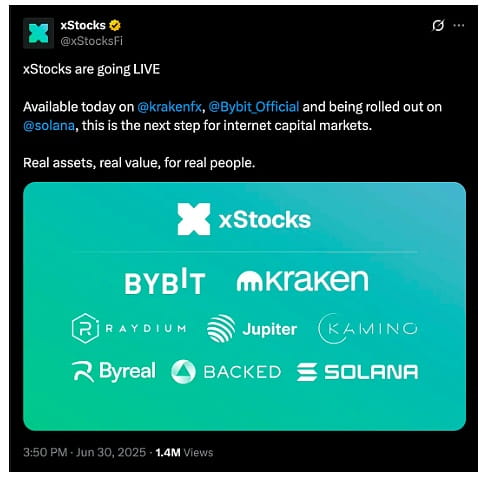
Source: X
Users can now self-custody stocks in wallets like Phantom or Solflare. Fractional ownership starting at $1 makes global access more convenient, especially for users in restricted regions. However, liquidity for most tokens outside blue-chip stocks remains weak. Weekend price discovery is also limited. Despite these challenges, institutional investor support and increasing demand suggest rapid growth in the future.
Ecosystem Highlights: Collaboration and Integration
Strong infrastructure partnerships connect traditional finance with blockchain rails, accelerating Solana's RWA growth.
Jupiter and the Kazakhstan Stock Exchange:
Jupiter's collaboration with the Kazakhstan Stock Exchange (KASE) explores dual listings. The goal is to allow companies to conduct IPOs on the KASE while issuing tokenized stocks on Solana. This will make Kazakhstan a pioneer in hybrid capital markets and marks a growing global trust in public blockchain finance.
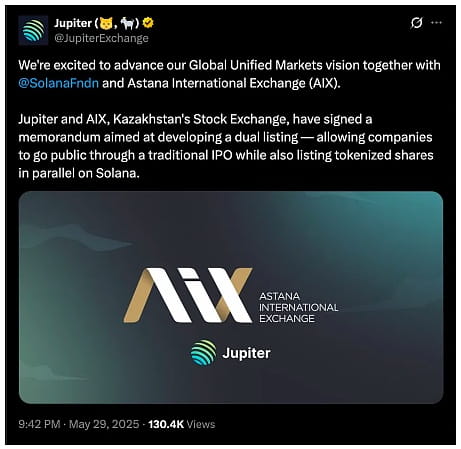
Source: X
Stablecoins: Circle and Paxos:
USDC and USDP play a crucial role in RWA settlements. Their integration with Solana enables instant, low-cost settlements and cross-border transfers for tokenized tools like U.S. Treasury bonds and bonds. These stablecoins enhance the liquidity and availability of financial operations.
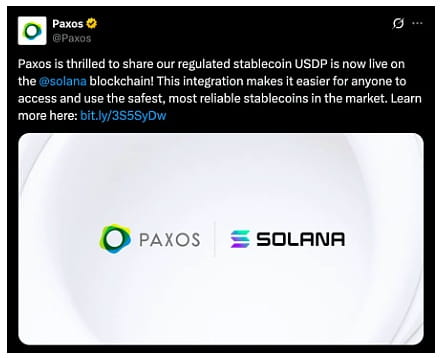
Source: X
Wallets, custodians, and compliance infrastructure:
For institutions, secure custody and compliance are crucial. Fireblocks, Anchorage, and Copper provide institutional-grade custody services. Fractal and Civic handle identity verification. Wallets like Backpack and Phantom are adjusting to support financial tokens, enhancing the user experience for both retail and institutional investors.
The rise of human finance and income-supported loans:
Huma Finance introduced income-based lending on Solana through its PayFi protocol. It allows users to use income streams such as payroll or invoices as collateral. Huma's PST token enables these income streams to access DeFi strategies using Jupiter, Kamino, and RateX. This introduces a new layer of credit to the RWA ecosystem, merging DeFi's composability with real-world financial data.
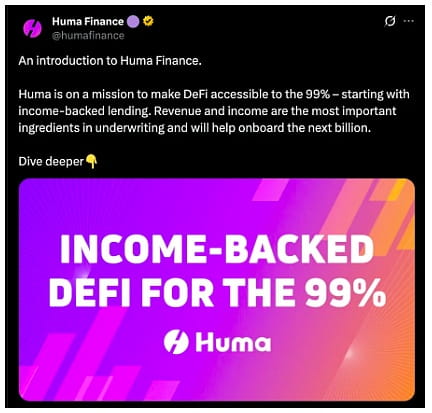
Source: X
xStocks on Jupiter:
Jupiter has integrated xStocks, allowing users to trade U.S. stocks on-chain with low fees and self-custody. The collaboration between Kraken, Backed Finance, and Solana aligns with Jupiter's mission to achieve permissionless access to traditional markets globally.
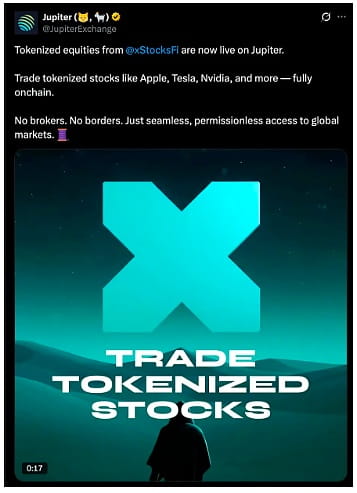
Source: X
Panorama of RWA Ecosystem on Solana
As RWA grows on Solana, protocols are organized into functional categories.
Tokenized government bonds
Ondo Finance: Offering OUSG, a tokenized short-term government bond.
Superstate: Institutional-grade yield assets.
Franklin Templeton: The FOBXX fund is now live on Solana.
BlackRock BUIDL Fund: Issued via Securitize and bridged to Solana.
Lending and underwriting
Maple Finance: Providing low-collateral loans for institutions.
Huma Finance: On-chain income-supported loans.
Credix: Financing through off-chain income (potential Solana integration).
Infrastructure and compliance
Custodians: Fireblocks, Copper, Anchorage.
KYC/AML: Fractal, Civic
Securitize: Legal transfer and compliance for tokenized funds.
Institutional Integration
R3's Corda: Connecting financial giants to Solana.
Kazakhstan Stock Exchange: Exploring tokenized dual listings.
BlackRock and Franklin Templeton: Actively distributing tokenized funds.
Exchanges and secondary markets
Jupiter: RWA liquidity aggregation.
Phoenix, Orca, Meteora: Supporting RWA token listings.
Wormhole and DLN: Cross-chain asset settlement.
Solana's RWA stack is not isolated. It is an interconnected financial infrastructure encompassing issuance, custody, trading, and compliance.
Global Regulatory Outlook: Coordinating Traditional Finance (TradFi) with Decentralized Finance (DeFi)
Regulators are slowly catching up with the RWA trend.
United States:
The U.S. remains fragmented. The SEC and CFTC often clash, but recent legislative efforts aim to clarify the status of stablecoins. The activities of BlackRock and Franklin Templeton indicate that, despite slow rule-making, a regulated path forward does indeed exist.
European Union:
The MiCA regulation set to be introduced by the EU in 2025 will provide clear definitions for stablecoins and tokenized assets. As pilot projects for digital bonds and tokenized funds progress, the EU is creating a structured and open environment for blockchain finance.
Asia:
Singapore supports tokenized finance through projects like the 'Project Guardian' backed by the Monetary Authority of Singapore (MAS). Hong Kong has issued licenses to cryptocurrency service providers. Kazakhstan is experimenting with Solana-native IPOs, becoming an emerging frontier market.
Regulators across regions are accepting tokenized government bonds and differentiating between consumer-level DeFi and institutional-grade tools. Jurisdictions that provide clear regulations and sandbox support will attract more RWA builders. Solana's compliance tools place it in a leading position.
Opportunities and Future of RWA on Solana
RWA is just getting started. Solana's architecture is empowering new asset classes and more convenient financial services.
Beyond government bonds: Real estate, private credit, and stocks:
Next up are tokenized real estate and private credit. Real estate can be fractionalized to enhance liquidity, while private credit can be serviced through transparent, programmable smart contracts. xStocks and Kazakhstan's dual listing pilot showcase how tokenized stocks will develop globally.
Composable RWA DeFi:
Solana's composability allows RWA to be used across protocols. Tokenized treasury bonds or real estate tokens can be collateralized, traded, or staked. This transforms assets into programmable financial primitives.
Retail-friendly products and yield enhancement
In the future, applications will emerge to help users allocate savings into baskets of tokenized assets. Solana's low fees and rapid confirmation capabilities make retail-level, user-friendly tools possible. Users can now purchase U.S. stocks through crypto-native interfaces, earn yields, or take out loans collateralized by tokenized ETFs.
Emerging Markets: Latin America, Africa, and beyond:
In regions hit by inflation or lacking banking services, tokenized dollars or stocks are a lifeline. Solana's speed and price advantages make it an ideal choice for the large-scale deployment of RWA in these markets. Mobile access, native stablecoins, and community participation are key drivers.
Personal Insights
RWA momentum is strong, but also faces the following challenges:
Liquidity fragmentation:
Different platforms have varying standards for issuing assets, making interoperability difficult. Jupiter provides assistance at the aggregation layer, but deeper cross-protocol integration is needed. Issues of slippage and pricing mismatches persist, especially on weekends.
Legal enforceability:
Asset tokenization does not guarantee executable rights. Legal agreements and clarity are crucial for global adoption. Differences in cross-border jurisdictions complicate asset validity and investor protection.
Custody and compliance risks:
Smart contract risks, poor wallet management, and lack of insurance are all barriers. Institutions need solid custodial and compliance frameworks. Even KYC and AML hurdles can slow down onboarding.
Building trust with traditional investors:
Institutions expect clarity, control, and reliability. The blockchain user experience must continually evolve to match traditional platforms. Education, transparency, and trust will be as important as performance or innovation.
Conclusion: Solana's RWA Advantage
Solana is no longer just a fast chain. It is a financial platform actively custodizing large-scale RWA. With the support of companies like BlackRock, Franklin Templeton, and Kraken, it has evolved into a legitimate foundational layer for global finance.
RWA brings familiarity and regulation to DeFi. Their emergence indicates that DeFi is transitioning from speculative hype to efficient capital markets. Solana's speed, composability, and infrastructure give it a unique ability to lead this new wave.
The launch of tokenized stocks by Robinhood on Arbitrum, along with the growing institutional support for Solana, indicates that this is just the beginning. Tokenized stocks, private equity, and 24/7 trading will become the norm. The wealth effect will spill over into DeFi, stablecoins, and even the meme sector.
Now is the time for builders to create practical tools, for institutions to modernize their offerings, and for regulators to help build effective frameworks.
TradFi and DeFi are merging, and Solana is the place to build this future.



